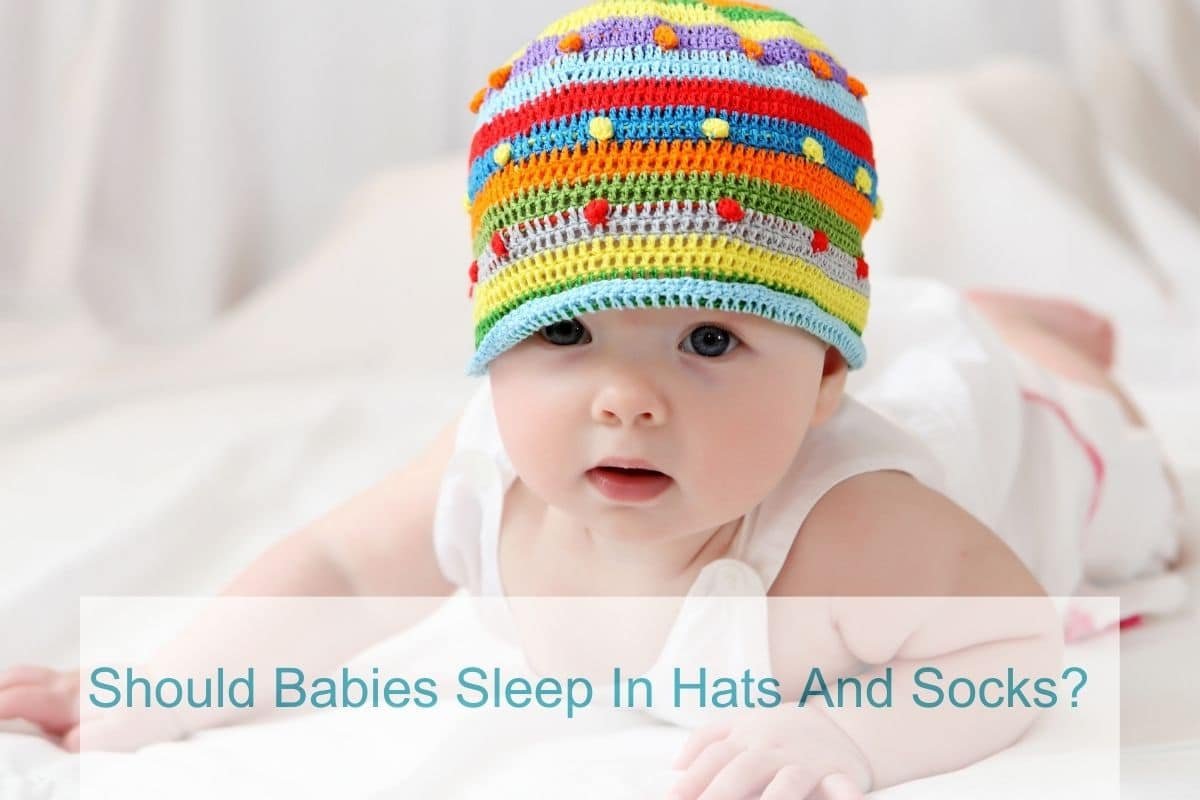As a new parent, you may be wondering whether your baby should wear a hat and socks while sleeping. The answer is no, babies should not wear hats or socks while sleeping. According to the American Academy of Pediatrics, overheating is a risk factor for Sudden Infant Death Syndrome (SIDS), and hats and socks can cause your baby to overheat.

While it may seem like a good idea to keep your baby warm and cozy with a hat and socks, it’s important to remember that babies have a harder time regulating their body temperature than adults. Overheating can cause your baby to become restless, irritable, and even increase the risk of SIDS. Instead of hats and socks, dress your baby in a one-piece sleeper and use a sleep sack or swaddle to keep them warm and cozy without the risk of overheating.
In addition to avoiding hats and socks, there are other safe sleep practices that parents should follow to reduce the risk of SIDS. These include placing your baby on their back to sleep, using a firm sleep surface, and keeping soft objects and loose bedding out of the crib.
The Importance of Safe Sleep Practices

As a parent, I understand the importance of ensuring that my baby gets a good night’s sleep. It’s vital to protect my little one from any potential risks, including Sudden Infant Death Syndrome (SIDS). One of the ways to ensure that my baby is safe while sleeping is by following safe sleep practices. In this section, I will discuss the importance of safe sleep practices for babies.
Reducing SIDS Risks
SIDS is a sudden and unexplained death of an infant under one year of age. While the exact cause of SIDS is unknown, there are some factors that increase the risk of SIDS. By following safe sleep practices, parents can reduce the risk of SIDS. One of the most important safe sleep practices is placing the baby on their back to sleep. This position is the safest and reduces the risk of SIDS by up to 50% [1].
Another important safe sleep practice is to avoid bed-sharing with the baby. While it may be tempting to sleep with the baby, it increases the risk of SIDS. Instead, parents should place the baby in a separate crib or bassinet in the same room for at least the first six months of life [2].
Temperature Regulation for Infants
Another important aspect of safe sleep practices is temperature regulation for infants. Babies are unable to regulate their body temperature as effectively as adults. As a result, they are more susceptible to overheating or becoming too cold.
Overheating is a risk factor for SIDS, so it’s important to keep the baby’s room at a comfortable temperature between 68-72°F [3].
While it may be tempting to dress the baby in hats and socks to keep them warm, it’s not necessary. In fact, the American Academy of Pediatrics advises against dressing the baby too warmly or using blankets, pillows, or bumpers in the crib. Instead, parents should dress the baby in a wearable blanket or sleep sack to keep them warm without the risk of suffocation [4].
Understanding Baby’s Sleepwear

As a new parent, choosing the right sleepwear for your baby can be a daunting task. In this section, I will share some information on appropriate clothing materials and seasonal considerations for sleepwear.
Appropriate Clothing Materials
When it comes to choosing sleepwear for your baby, it is important to consider the materials used. Soft, breathable materials like cotton or bamboo are great options as they allow air to circulate and prevent overheating. Avoid synthetic materials like polyester or nylon, which can trap heat and cause discomfort.
It is also important to choose sleepwear that fits your baby well. Loose-fitting clothing can be a safety hazard, as it can cover your baby’s face and increase the risk of suffocation. On the other hand, clothing that is too tight can restrict movement and cause discomfort.
Seasonal Considerations for Sleepwear
The temperature of your baby’s sleeping environment should also be taken into consideration when choosing sleepwear. During the warmer months, lighter clothing like onesies or lightweight sleep sacks are appropriate. In colder weather, long-sleeved onesies or footed pajamas can help keep your baby warm.
While it may be tempting to dress your baby in multiple layers to keep them warm, it is important to avoid overheating. Overheating can increase the risk of Sudden Infant Death Syndrome (SIDS). A good rule of thumb is to dress your baby in one additional layer than what you are comfortable wearing.
Pros and Cons of Hats and Socks for Babies

Benefits of Wearing Hats and Socks
As a mother, I have always wondered if it is necessary for my baby to wear hats and socks while sleeping. After doing some research and consulting with my pediatrician, I have found that there are some benefits to having your baby wear hats and socks while sleeping.
One of the main benefits of wearing hats and socks is that they can help regulate your baby’s body temperature. Babies have a hard time regulating their body temperature, and wearing hats and socks can help keep them warm and cozy during the night. This is especially important during the colder months when the temperature drops.
Another benefit of wearing hats and socks is that they can protect your baby’s delicate skin. Hats can protect your baby’s head from the harsh sun, and socks can protect their feet from the cold floors. This is especially important for babies who are just learning to crawl and walk.
Potential Risks and Disadvantages
While there are some benefits to wearing hats and socks, there are also some potential risks and disadvantages to consider. One of the main risks of wearing hats and socks is that they can cause your baby to overheat. This can be dangerous, especially if your baby is swaddled or wrapped in a blanket.
Another potential disadvantage of wearing hats and socks is that they can be uncomfortable for your baby. If your baby is already fussy or uncomfortable, adding more clothing to their body can make them even more irritable.
It is important to note that the American Academy of Pediatrics recommends against using hats and other clothing items that can cover a baby’s face while sleeping. This can increase the risk of suffocation and Sudden Infant Death Syndrome (SIDS).
Guidelines for Dressing Babies for Sleep

As a parent, I understand the importance of ensuring that my baby is safe and comfortable while sleeping. One of the common questions that many parents have is whether babies should sleep in hats and socks. In this section, I will provide some general recommendations and safety tips to help you dress your baby for sleep.
General Recommendations
When dressing your baby for sleep, keep in mind that babies cannot regulate their body temperature as well as adults can. Therefore, you need to dress your baby appropriately for the room temperature. A good rule of thumb is to dress your baby in one more layer than you would wear to be comfortable in the same environment.
For example, if you are comfortable in a t-shirt and shorts, you should dress your baby in a onesie and a light sleep sack. On the other hand, if you are wearing a long-sleeved shirt and pants, you should dress your baby in a onesie, a footed sleeper, and a heavier sleep sack.
Sleepwear Safety Tips
It is important to choose sleepwear that is safe for your baby. Here are some safety tips to keep in mind:
- Avoid dressing your baby in clothes that are too loose or too tight. Loose clothes can bunch up around your baby’s face and increase the risk of suffocation, while tight clothes can restrict your baby’s movement and cause discomfort.
- Do not use blankets or pillows in your baby’s sleep area. Instead, use a sleep sack or a wearable blanket that fits snugly around your baby’s body.
- Choose sleepwear that is made of breathable materials, such as cotton. Avoid synthetic materials, which can trap heat and cause your baby to overheat.
- Do not dress your baby in a hat or socks while sleeping, as this can increase the risk of overheating. Instead, dress your baby in a onesie and a sleep sack, and adjust the room temperature as needed.
Alternatives to Hats and Socks
As a parent, you may be wondering if hats and socks are necessary for your baby to sleep comfortably. While they can provide warmth, there are alternatives that can achieve the same result without the potential risks. Here are some options to consider:
Sleep Sacks and Swaddles
Sleep sacks and swaddles are great alternatives to hats and socks. They are designed to keep your baby warm without the need for additional clothing. Sleep sacks are like wearable blankets that zip up around your baby, while swaddles wrap your baby snugly in a blanket. Both options can help your baby feel secure and comfortable while sleeping.
Room Temperature Control
Another alternative to hats and socks is to regulate the temperature of your baby’s room. It’s recommended to keep the room between 68-72°F (20-22°C) for optimal sleep conditions. You can use a room thermometer to ensure that the temperature is just right. If the room is too cold, you can add an extra layer of clothing or a sleep sack. If the room is too warm, you can remove a layer of clothing or use a fan to circulate air.
Remember, hats and socks are not necessary for your baby to sleep comfortably. There are alternatives that can provide warmth and comfort without the potential risks. By using sleep sacks and swaddles or regulating the temperature of your baby’s room, you can help your baby get a good night’s sleep.

